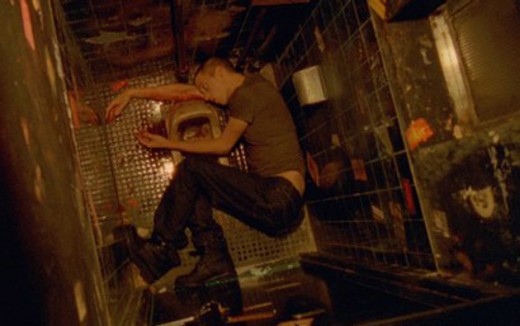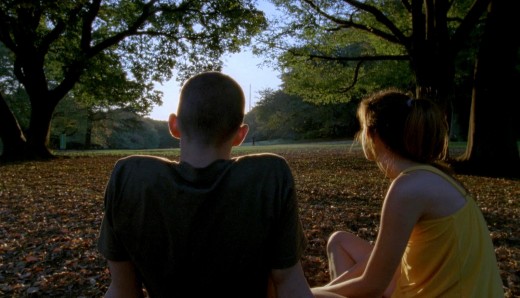Spoiling for the Afterlife – The Psychedelicised New Film from Gaspar Noé
This is such an incredible film that I feel I need to give out two spoiler alerts before the review. One, for the plot points about to be mentioned. And another for the afterlife itself, as director Gaspar Noé may just have given us the best cinematic glimpse so far.
After Noé disposes of the entire credit roll at the front-end of the film, battering the audience with a pile-up of gaudy, flashing neon typography and accompanying concussive, machine-gun techno, we find ourselves on the balcony of a small Tokyo apartment and behind the eyes of a young American man in conversation with his sister. This is Oscar, a small-time drug dealer and user. We see the film firstly through his eyes – literally – for the first thirty minutes or so, including through his mind’s eye after he smokes DMT and his perspective goes inwards for roughly four minutes of uninterrupted screen time. Strange and beautiful pseudo-organic abstract forms writhe onscreen, inviting the viewer to either dispense with usual notions of drama and narrative, or to bail out now; as in a psychedelic experience, the choice is either to resist or let go.
Not since Avatar has a film experience been as immersive. “It's kind of a stupid movie, at least in terms of story,” says Noé of Avatar. "But, wow -- I have the feeling that James Cameron has taken some of the same drugs I did.” Which, for Noé , has included mushrooms and the DMT-containing ayahuasca of the Amazon. Of the latter he's commented, “You forget that you have a human form and that you're on a planet. It's a really hardcore experience that I absolutely do not regret.” I might say the same of watching Enter the Void.
Roughly thirty minutes in, our man, the audience’s very own avatar, is betrayed by a client and shot by Tokyo police. As his body lies bleeding on the floor of a toilet cubicle our perspective drifts up and out, speeding to those significant others left behind in the initial aftermath, scrolling efficiently across the city like Google Earth. After even a relatively short period of this, during a brief lull, I reflected, surprising myself, that I still had a body, and that following this filmic experience I would actually have to once more take up the weighty responsibility of the flesh and head back out into the world. Unlike Oscar, I was still in the game.

In one of the film’s most moving scenes, Oscar’s incorporeal observer witnesses his sister receive news of his death, via an equally disembodied voice delivered by mobile phone. Pathetically alone in the changing room of the strip club where she works, she crumples to a couch, our viewpoint misting and drifting, as if signifying the intense love and crushing impotence of her watching, late brother, as he grieves for his own life and for the loss of his still living sister.
So, what kind of afterlife is this? The film’s vision has been criticised by one reviewer in the Sunday Times as “a banal conception of the hereafter”. Elsewhere, the accusation has been of “self-indulgence”. Both criticisms miss the mark, however. Enter the Void should rather be appreciated not simply as an act of artistic creativity but rather as a kind of reportage, an attempt to create a cinematic simulacrum of how it will really be when we die.
Eschewing any Judeo-Christian influence or schmaltzy Hollywood hopefulness, the afterlife here depicted rather represents a kind of inbetween bardo state, as depicted in The Tibetan Book of the Dead, a book which Oscar had conveniently-significantly-synchronistically been reading in the days before he is shot, and which Alex, the friend who loaned him the book, succinctly summarises as they stroll the Tokyo backstreets towards Oscar’s date with destiny. According to this Buddhist classic, during such post-death transition periods, consciousness remains attached to the “banal” details of the life just lived, which, as the film brilliantly shows, now become drenched with psycho-spiritual significance.
A more sympathetic feature in The Sunday Times described the drifting, disembodied, narrative style thusly, “[the main character] can shift in space and time, revisiting and reassessing all his yesterdays ... It's a compelling cinematic technique and an effective tool for telling a moving and remarkable story of a ‘wasted’ life’.” More than this, though, it may actually be the “technique” enlisted by our own physiology, as attested by many survivors of near-death experiences in their descriptions of the strange “panoramic life review” component of such events, often summed up as having their life “flash before their eyes”.

These are more than just memories. During these moments of the film, Oscar’s viewpoint hovers just behind the head of corporeal Oscar, as various significant events from his life are replayed. Scenes melt into each other, time and space rearranged by the human psyche, or perhaps the human heart, according to personal themes and, as we orbit various sexual, emotional and visceral episodes, according to the base notes of all of our core, biopsychic drives, which our egos and cultures in life conspire to otherwise adorn and disguise in the myriad fineries of existence.
As the film goes on, Oscar’s consciousness, as foreshadowed by The Tibetan Book of the Dead, sifts the details of the life just lived as it makes its journey back towards rebirth. Due to his love for, and attachment to, his sister, his consciousness finds itself constantly returning to her, until, ultimately, it penetrates her body at the point she conceives to Oscar’s friend Alex, suggesting he will become her child and fulfil his earlier promise to never leave her.
Then, like a violent rollercoaster decelerating to a stop with whiplash force, we the audience are as violently deposited back into The Void, robbed of the soothing filmic decompression of the credit roll, borne back into our lives amidst the deluge of the clinical house lights. I find myself as avidly watching the reactions of my fellow audience members, looking to see if they are as beautifully brutalised as I. Outside, in overcast grey Soho, I wander back to the underground in a daze, staring in wonder and horror at the throng of other souls, determined now to make my moments count more, to care more, to be conscious more, changed for the moment by a work of art so great I feel it a spiritual text. He nailed it, I say to myself. He nailed it.
I find my mind returning to the film for the rest of the day and in the days that follow, exactly in the way it would to a strange, beguiling dream, attempting to piece it back together, to remember, to unearth meaning, and to reflect on its sheer spectacle. “The ultimate movie for me would be the movie that accesses the way dreams are written in the brain”, says Noé.
It's stating the blindingly obvious to say this film will not be for everyone. Watching Enter the Void will be, for most, the cinematic equivalent of Peter Fonda bumming out John Lennon while they tripped on acid at that sixties party (famously inspiring the song, She Said She Said): "Hey man, I know what it's like to be dead." Most people just don't want to know such things. No, this film is not for everyone. Death itself, however, will be another matter. That, says fellow psychenaut Alex to Oscar early on, “would be the ultimate trip.”
Like any great artist, Noé seems to want to avoid dogmatism, muddying the waters, preferring to raise questions rather than provide easy answers. Most notably, the face of the woman giving birth at the end of the film – and it’s easy to miss - is not that of Oscar’s sister but is actually his mother. “[S]o you don't know if you're seeing his original birth, he's recreating a false memory of that traumatic moment that was his birth when he discovered light and oxygen. Or is he just getting into a loop, and your perception of time is only likened to how your brain is built.”
Or is the whole film just one long DMT-induced dream? Is the near death experience itself, as recounted by those who come back to tell the tale, likewise “just” a DMT-induced delusion (one of the most powerful hallucinogens known to man, which also naturally occurs in the brain)? Is all religious experience just a chemicalised delusion in the brain?
Surprisingly, for someone who has dedicated years to the development of such an ambitious and profound project, Noé tends towards a nihilistic agnosticism, shockingly encapsulating the subject of the film as “the sentimentality of mammals and the shimmering vacuity of the human experience.”
Firmly closing the door on more religious explanations, he explains, “"[T]he whole movie is a dream of someone who read The Tibetan Book of the Dead, and heard about it before being [shot]. It's not the story of someone who dies, flies and is reincarnated. It's the story of someone who is stoned when he gets shot and who has an intonation of his own dream.” So, that’s it then. It’s just a ride.
Welcome to The Void.





